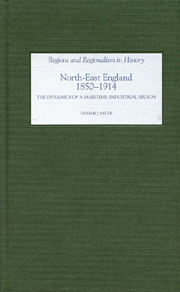Book contents
- Frontmatter
- Contents
- Dedication
- List of illustrations
- Preface
- 1 The North East in time and space
- 2 Horizons: ports, trade and mobility
- 3 Hinterlands and industrial districts
- 4 Making and managing the maritime landscape
- 5 Cohesion and diversity in the maritime urban system
- 6 The horizons of North East shipowning
- 7 Business and the maritime-industrial complex
- 8 Conclusion
- Sources and bibliography
- Index
4 - Making and managing the maritime landscape
Published online by Cambridge University Press: 12 September 2012
- Frontmatter
- Contents
- Dedication
- List of illustrations
- Preface
- 1 The North East in time and space
- 2 Horizons: ports, trade and mobility
- 3 Hinterlands and industrial districts
- 4 Making and managing the maritime landscape
- 5 Cohesion and diversity in the maritime urban system
- 6 The horizons of North East shipowning
- 7 Business and the maritime-industrial complex
- 8 Conclusion
- Sources and bibliography
- Index
Summary
Most economic history textbooks emphasise that being close to water was a fundamental element in industrialisation. Water was a raw material in many processes, and it was a source of power for machines. More generally, water transport was, and remains, the only economic method of carrying bulk commodities over long distances. Being close to water, however, is not the same thing as being close to useable water, especially in the transport sense. The textbooks are less forthcoming on the enormous technical, financial and political effort needed to turn shallow rivers and exposed coastlines into ports and transport arteries capable of handling shipping. The processes involved in making water navigable and managing its subsequent exploitation need closer study in light of those broader questions, and also given the evident importance of rivers and ports to the internal and external affairs of the North East, as revealed in the previous chapters.
Port improvement and management were areas of constitutional neglect at a national level in early Victorian Britain. While the naval and customs aspects of ports had long been of interest to central government, Britain never developed a national policy for commercial ports during this era. The Royal Commission on Tidal Harbours did argue for a national body to take over the conservancy of tidal ports in 1846 as part of a damning report into the lack of accountability of port authorities in many parts of the country, and the wasteful competition that resulted from competing jurisdictions – its recommendations were rejected, however, as being too great an infringement on local autonomy.
- Type
- Chapter
- Information
- North East England, 1850–1914The Dynamics of a Maritime-Industrial Region, pp. 80 - 110Publisher: Boydell & BrewerPrint publication year: 2006



